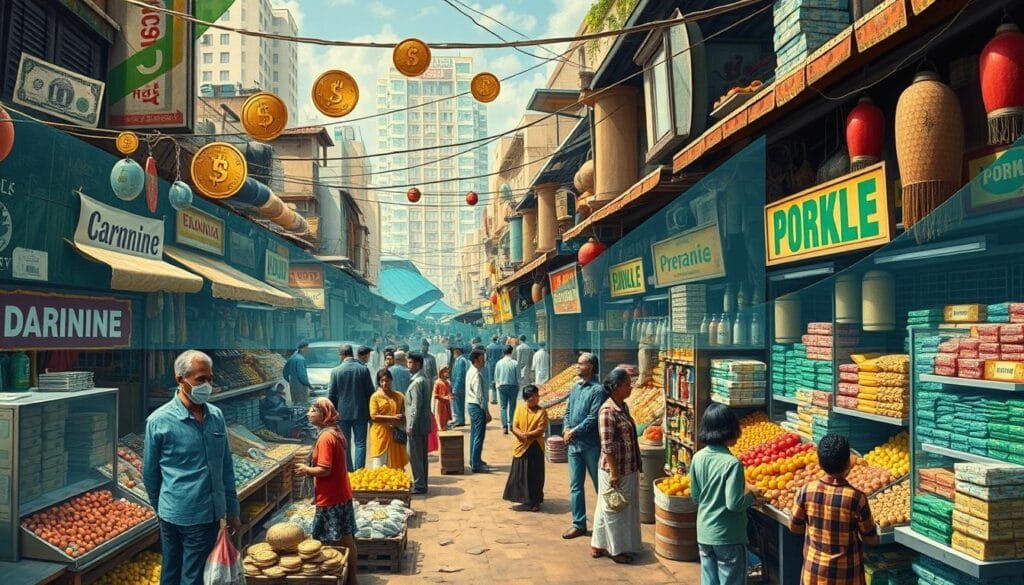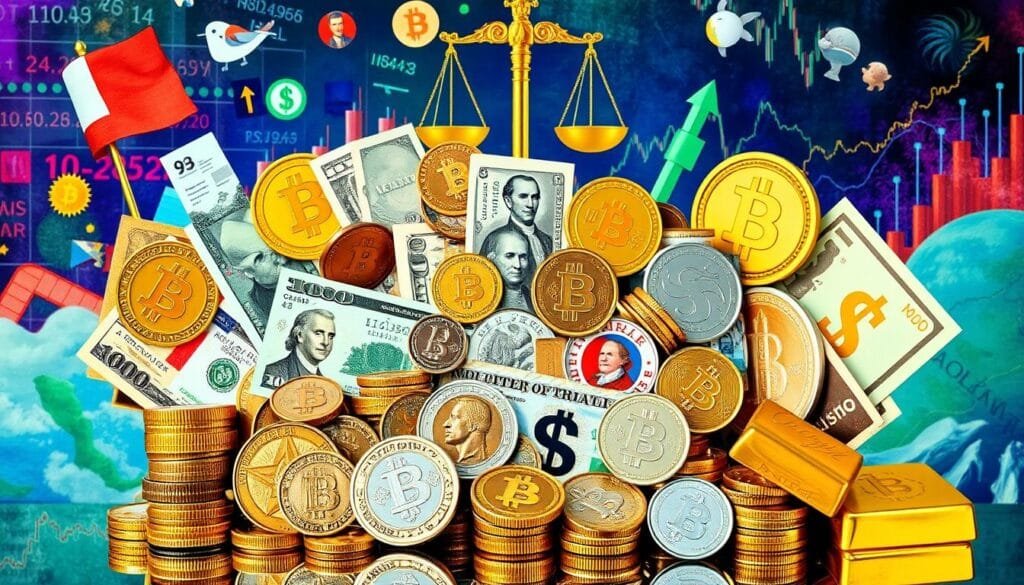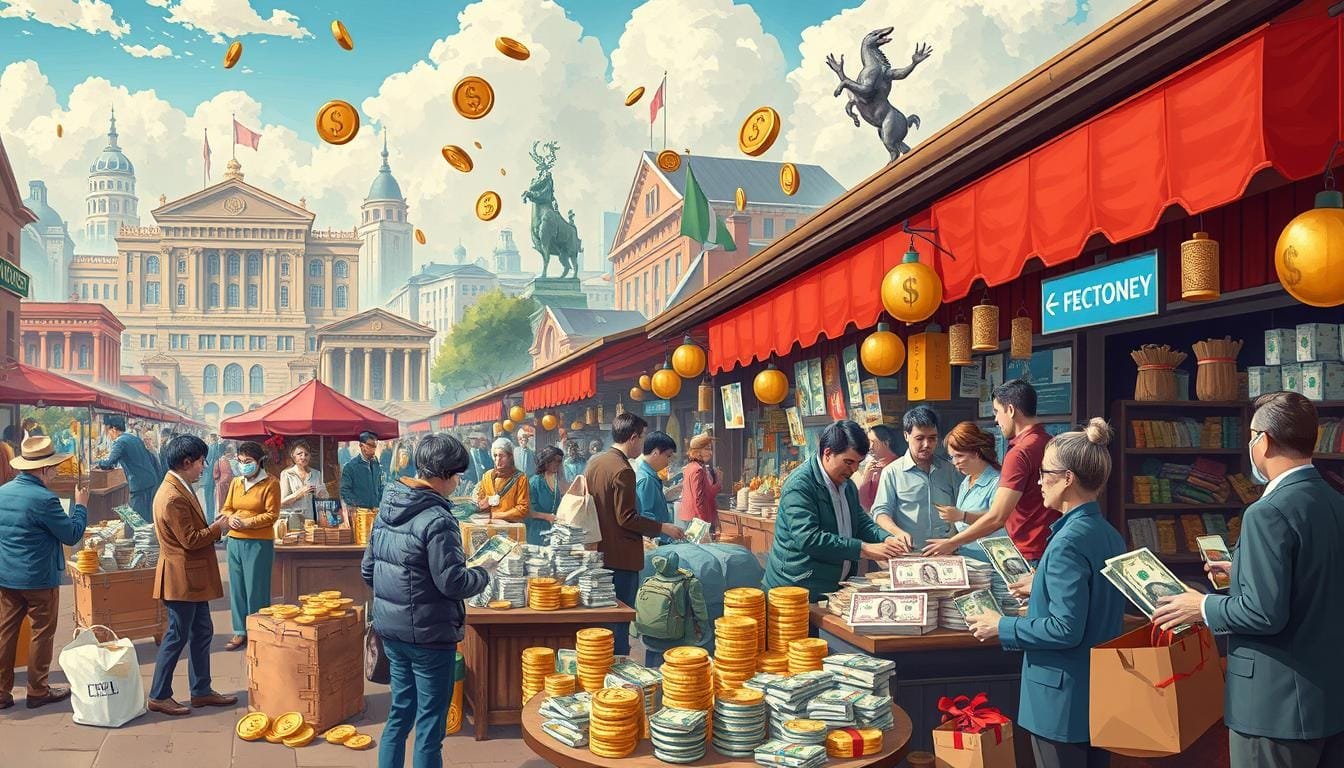Have you thought about why money affects our lives and the world economy? From bartering with goods to using digital currencies, money is key to economic health and expansion. Understanding money’s economic roles helps us see how it shapes strong financial systems and policies.
Key Takeaways
- The total value of the M1 money supply in the United States stood at $18.32 trillion in August 2023.
- The shift from barter to money has greatly reduced transaction costs.
- Historical currencies included everything from agricultural commodities to cigarettes.
- Fiat currencies derive their value from government stability and market demand.
- Cigarettes served as a form of currency in World War II prisoner-of-war camps.
- Modern monetary systems enhance economic stability through careful financial policies.
- Blockchain technology offers faster and cheaper transactions but comes with environmental costs.
Introduction to Money and Its Importance
Money is a key element in today’s economy. It makes transactions easy and helps keep the economy stable. The importance of money in economy is huge because it replaces old, complicated barter systems. Now, we have a simple and standardized way to trade.
Moving from barter to money cut down costs and made trading smoother. For example, to trade ten goods in a barter system, you’d need to know 45 exchange rates. With twenty goods, that number jumps to 190. Using money simplifies everything.
Money has some main jobs: it’s a way to save, measure, and trade value. These jobs keep economic activities stable and effective. Also, being easy to accept, divide, and carry around makes money really important.
Another big benefit of money is it helps track spending and trading. It also makes dealing with future trades easier. Clearly, having money boosts how well we can price goods and services.
During the COVID-19 pandemic, governments made more money available. They increased the money supply by about 20% to help the economy. This shows how vital money is, especially during tough times. Also, most countries use fiat money, showing how widely it’s accepted.
When comparing money vs barter, money’s advantages are clear. It supports complex economic activities in ways barter can’t. Digital currencies are rising, and soon, most countries will have digital bank currencies. This shows how money is evolving to meet our changing economic needs.
| Aspect | Money | Barter |
|---|---|---|
| Transaction Efficiency | High | Low |
| Complexity of Pricing | Simple | Complex |
| Record-keeping | Enhanced | Difficult |
| Economic Stability | Supports | Does not support |
| Global Acceptance | High | Low |
What Does Money Mean in Economics?
Getting to know what money means is key in understanding its role in the economy. Looking at money’s functions and its development helps us see the foundation of current economies.
Definition and Basic Functions
Money is defined by its use as a medium of exchange, store of value, and unit of account. These roles help with trade, wealth saving, and setting prices.
- Medium of Exchange: Money makes buying and selling easier without trading goods directly.
- Store of Value: Money keeps its value over time, even if inflation can change it.
- Unit of Account: Money gives a consistent way to value goods and services.
Historical Context and Evolution
Throughout history, money has taken many forms like livestock, grains, and metals. We’ve gone from using actual items to relying on fiat money, which the government backs.
In recent years, changes in money have been significant. For example:
- Commodity Money: Valuable items like gold and silver were used.
- Representative Money: Paper money could be traded for a set amount of a commodity.
- Fiat Money: Currency that doesn’t have value itself but is used because the government says so.
- Digital Money: Technology has brought us digital currencies and electronic payments.

| Aspect of Money | Historical Example | Modern Example |
|---|---|---|
| Commodity Money | Gold, Silver | N/A |
| Representative Money | Silver Certificates | N/A |
| Fiat Money | U.S. Dollar | U.S. Dollar |
| Digital Money | N/A | Cryptocurrencies |
Money’s evolution shows our quest for better commerce and connection. For instance, the U.S. M2 money supply was $20.5 trillion by late 2021. This was a 25% jump, showing how money usage shifted during the pandemic.
Also, 70% of banks now see digital currencies as a big future change. This view points to money’s ongoing evolution, showing how our society and economy adapt and grow.
The Role of Money in Market Economics
Money is a key element in market economics. It acts as a way to trade, a measure of value, and a store of wealth. It also lets us pay for things later. Money solves the problems of barter systems, where wants had to match perfectly.

Eliminating Barter and Reducing Transaction Costs
Barter economies struggle due to the need for exact matches in trade desires. Money removes this need for a perfect match, making trading easier. With barter, trading big items or things that go bad was hard. Money is accepted everywhere, can be split easily, and is hard to fake, making trades smoother.
Standardization and Comparability
Money makes trading simpler by standardizing values. With money, comparing prices is straightforward. Gold, for example, has been a reliable standard because everyone knows its value. It is divisible and hard to counterfeit. This made gold a key standard, backing the value of many goods and services.
Digital Transformation of Money
Money is now transforming digitally, keeping up with tech improvements. Most of the world’s money is now digital. In 2023, the U.S. had about $21 trillion in digital money. Digital transactions dominate in developed countries. Also, 60% of U.S. small businesses choose digital payments over cash.
Cryptocurrencies are part of this change, with 16% of people worldwide using them. This digital shift makes trading cheaper and updates market economics. It makes markets more efficient and accessible to everyone.
Understanding Different Types of Money
There are four main kinds of money in today’s economics: fiat, commodity, fiduciary, and commercial bank money. Each type has a special role in our financial systems. They impact how we do our daily buying and selling.
Market-Determined Money
In the past, market-determined money included things like gold, silver, and copper. These were valued for their real, physical worth. Goods such as tobacco and seashells also played this role in various cultures.
Although no country uses the gold standard today, it was once vital. The gold standard linked money’s value to a set amount of gold. Countries like the United Kingdom in 1812 and the US, Germany, and France in the 1870s adopted it. Yet, the gold standard fell out of use because of its economic limits during events like World War I.
Government-Issued Currency
Nowadays, government-issued currencies form a more modern type of money. This category includes coins made from precious metals. These coins have been controlled by governments. For example, there were gold, silver, bronze, and copper coins.
Fiat money is now the main type of money, not based on any physical commodity. The term “fiat” means “determined by authority.” This shows its value is set by governments. Paper money, also a fiat currency type, is controlled by governments to keep the economy stable.
Fiat and Fiduciary Media
Fiat money makes up most of today’s currency systems. It’s valued by government decree, not physical assets. As of 2022, around 90% of global money is fiat. This shows a big move away from systems based on commodities.
Fiduciary media, like cheques and banknotes, depend on trust. They’re valuable when turned into fiat money. Commercial bank money also matters a lot. It comes from customer deposits and loans. For instance, with a 10% reserve, a bank can lend out most of the rest. This helps to grow the money supply.

Electronic money has made transactions up to 200% faster. This boost helps with quicker exchanges. In developed economies, about 75% of dealings use commercial bank money, not physical cash. This shift towards digital and intangible money shows how our financial system is becoming more efficient and adaptable.
Conclusion
The journey through the economic impact of money shows its deep influence in all parts of society. From early trade systems to digital currencies, money has always changed to suit economic needs. It has shaped trade, policy, and social structures through different forms like market currencies and government money.
Understanding the roles of money is key when looking at its future and effects on policies. By looking at money’s history and today’s use, we understand economic theories better. Works like “Modern Money Theory: A Primer on Macroeconomics for Sovereign Monetary Systems” help us see how these ideas affect current policies. These theories highlight that governments can spend without limits, except those they set themselves.
The future of money in digital form brings both chances and issues. Important qualities like being easy to carry, lasting, and holding value are essential. But digital money makes us think again about these points. By staying up-to-date and flexible, we can prepare for how these changes will shape our economic policies. This way, money will stay an essential part of keeping the economy stable and growing.
FAQ
What are the primary economic functions of money?
Money serves three key roles in the economy. First, it’s a medium of exchange, making buying and selling easier. Second, it acts as a store of value, preserving wealth over time. Lastly, it’s a unit of account, standardizing the measure of goods and services.
Why is money important in the economy?
Money is vital as it moves us away from the barter system. It cuts down on transaction costs. Plus, it allows for more complex economic activities. Money smooths out trade and supports economic stability and growth.
What are the benefits of money over barter systems?
Money fixes barter system flaws by removing the need for a “double coincidence of wants”. It makes transactions simpler. Money also brings pricing standards and comparability into trading.
How has money evolved throughout history?
In the beginning, people traded using livestock or grains. Over time, they switched to standard currencies like gold and silver. Now, we use digital currencies and electronic payments. This shows how our financial systems have evolved for better efficiency and connectivity.
What does money mean in economics?
In economics, money is anything widely accepted for exchange, value storage, and account unit. It enables trade, saves value, and prices goods and services.
How does money reduce transaction costs in market economics?
Money cuts down costs by being a common exchange medium, ditching the barter system. This makes transactions smoother and boosts economic productivity.
What is the significance of digital transformation in money?
Digital changes have made money transactions faster, easier, and safer. With digital currencies and electronic banking, we are moving towards less physical but more efficient money forms.
What are market-determined forms of money?
Historically, market-determined money includes commodities like gold and silver. Their value comes from their physical qualities and market acceptance.
What is government-issued currency?
This is money that governments say must be accepted for all debts. The US dollar and the euro are examples. They are known as legal tender.
What is the difference between fiat money and fiduciary media?
Fiat money has value because the government says it does, unlike physical money. Fiduciary media involves digital and electronic money, showing a shift towards convenience and speed in transactions.
